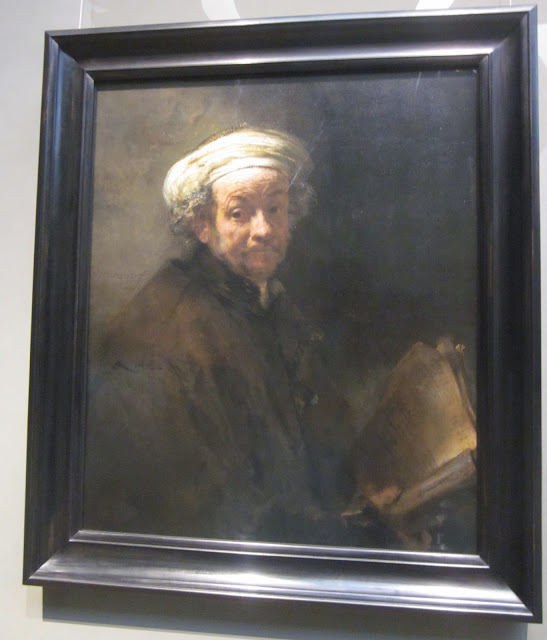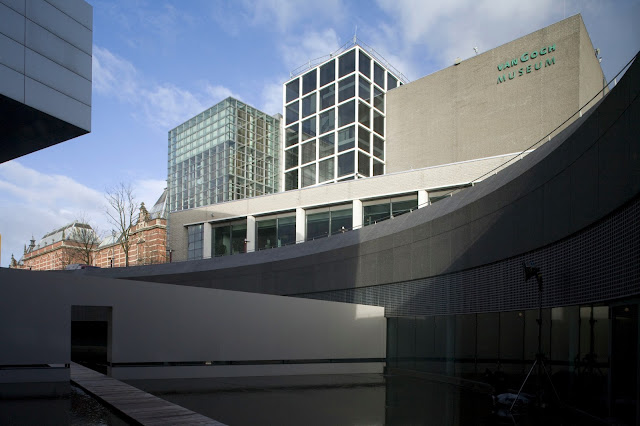The national art museum of the Netherlands, or Rijksmuseum, moved from the Hague to Amsterdam in 1806. The current building opened in 1885 and is part of a conglomeration of museums that includes the Van Gogh Museum and the Stedelijk Museum (which houses a much more modern collection of art than the Rijksmuseum, and which we were unable to fit into our tight schedule).
 |
| Photo from Wikipedia |
The obligatory "Cannon with a cannon" photo:
The museum is filled with art by the Dutch masters. Some of it looked like it should be familiar, like the painting below, which of course I have never heard of.
 |
Banquet of the Amsterdam Civil Guard in Celebration of the Peace of Muenster
by Barholomeu van der Helst (1648) |
The famous Delft blue violin on the left (c. 1705-1710) is not really playable, but the ballroom design on the front is exquisite. The oak cabinet on the right, dating back to the late 1600s, is inlaid with olive wood cut from a single tree.
One of the few modern pieces of art in the museum (2008,
Maarten Baas), this grandfather clock appears to have a man inside who erases and redraws the hands of the clock every minute. In between minutes he might disappear in the bottom of the clock, or he might just turn his back on the viewer. It looks like a real person is inside, but it must be some kind of video projection.
I love this imaginative work. The placard next to it reads: "If there is one word that sums up the essence of everything the Rijksmuseum does, it must be 'time'. An awareness of time and a sense of beauty--that's what the Rijksmuseum shows. Our tastes change and we grow older as relentlessly as times [
sic] passes by. The museum captures time, standing as a beacon in a changing world.
Another unusual piece of art is this
Mondrian Dress. The description reads, in part: "This is one of the purest models from fashion designer Yves St. Laurent's international breakthrough collection. It is based on the abstract geometrical paintings by Dutch artist Piet Mondrian (1872-1944)."
One more more contemporary piece by an artist with an unmistakable style caught my eye:
 |
| Queen Beatrix of the Netherlands, Andy Warhol (1985) |
In general, the descriptions of the art in the Rijksmuseum are much better than average. The one for this marble statue of Cupid reads: "Cupid, the god of love, quietly draws an arrow from his quiver. Meanwhile, smiling mischievously, he warns the observer to keep silent and not to betray him. Who the arrow was intended for is uncertain, but the threat is clear. On the pedestal the inscriptions states 'Whoever you are, this is your master. That he is, that he was, and that he will be.'"
 |
| Cupid by Etienne Maurice Falconet (1757) |
While the Rijksmuseum is relatively small, it is crammed with familiar art. How many of these do you recognize?
 |
| The Merry Fiddler by Gerard van Honthorst (1623) |
 |
| Self-Portrait by Rembrandt van Rijn (1628), painted when he was 22 years old |
 |
| Tobit and Anna with the Kid by Rembrandt van Rijn (1626) |
 |
Portrait of Gerard Bicker by Bartholomeus van der Helst (1642)
Note: This is the same artist who painted the banquet
of 100+ figures at the beginning of this post |
 |
Self portrait as the Apostle Paul by Rembrandt van Rijn (1661)
Here Rembrandt is about 55 years old |
 |
Woman in Blue Reading a Letter by Johannes Vermeer (1663)
My first Vermeer! |
 |
| The Kitchen Maid by Johannes Vermeer (1658) |
Next door to the Rijksmuseum is the Van Gogh Museum. In the picture below, the building in the background on the left is the Rijksmuseum.
 |
| Photo from Wikipedia |
I took only one or two pictures before I realized (with a little help from a guard) that no photos are allowed inside the museum. Pity. I did get a picture of this sign:
Interesting that the museum owns 200 paintings, 500 drawings, and 750 letters, "the bulk" of his body of work. Of all those wonderful paintings, I got one picture of this one, definitely not Van Gogh's most exciting:
 |
| Pollard Willow by Vincent van Gogh (1882) |
The museum has a wonderful collection, and what stood out to me was the number of self-portraits. If you are interested in what is part of the museum's permanent collection, go
here.
Our visit to Amsterdam and specifically to the Van Gogh Museum piqued my curiosity about this bizarre genius. After our trip I picked up the book
Van Gogh: The Life by Steven Naifeh and Gregory White Smith. These two men won the Pulitzer Prize in 1998 for their biography of Jackson Pollock. I had already read another book by this duo:
The Mormon Murders, the story of the Mark Hoffman murders, so I was familiar with their style.
This book is a fascinating look at Van Gogh and his times, but it is a daunting read, full of minutiae that stretches it out to 976 pages. I've made my way through about 75% of it, and I keep interrupting my reading for other books, but I continue to be drawn back to it. I can definitely recommend it.
There was one part of the museum where pictures
were allowed--the dry "pond" that was between the museum and an annex. The stones are laid out in the pattern shown in van Gogh's painting
Wheatfield with Reaper.
 |
Wheatfield with Reaper by Vincent van Gogh (1889),
part of the permanent collection of Amsterdam's Van Gogh Museum |
The last museum we visited was the Rembrandt House, where Rembrandt lived from 1639 until he went bankrupt in 1658. He paid 13,000 guilders for it, which was a huge sum, but he was a well-known, successful artist at the time. However, he was a much better artist than businessman, and his financial free-wheeling eventually led to his bankruptcy. All of his possessions were auctioned off, and a detailed list from the auction survived, which was used to recreate the interior of this house.
This 1630 self-portrait etching is the museum's logo. Rembrandt was twenty-four years old, and I think he must have had a pretty good sense of humor.
Ever the businessman, the entrance hall was filled with paintings by Rembrandt, his pupils, and other masters (mostly Dutch) that were available for purchase:
 |
This etching of Abraham and Isaac appears to be by Pieter Eastman (1585-1655),
but I haven't been able to find any information about the artist or the art. |
 |
| The kitchen |
Rembrandt's studio, which faces north to catch the best light, is the largest room in the house. Like many successful artists, he employed quite a number of assistants who made his paint and prepared his canvases.
There is a wonderful collection of Rembrandt's etchings on display. The introduction below notes that "Rembrandt was one of the greatest graphic talents of all time" and "his spontaneous drawing style is perfecting expressed in his etchings." Also, "The Rembrandt House Museum has some of the most important collections of Rembrandt prints in the world." He produced a total of about 290 prints.
The collection includes quite a few from a series depicting the life of Christ:
 |
| The Adoration of the Shepherds (1654) |
 |
| Jesus with His Parents (after they found him in the Temple) |
 |
| Christ Preaching |
 |
| The Return of the Prodigal Son (1636?) |
 |
| Christ Presented to the People (1655) |
There are also some etchings from the Old Testament:
 |
| Adam and Eve (1638) |
Of course, there are several self-portraits. After all, Rembrandt painted, drew, and etched himself over 90 times. On the left he includes his wife Saskia (1636), and on the right he poses in the style of portraits painted by Titian and Raphael (1639):
This is one of my favorites:
 |
| Beggar Man and Beggar Woman Conversing (1630) |
 |
| Not a very good photo, but I love the textured skin |
The museum information on the paintings above and below noted that they are lighting studies for other paintings.
 |
| Old Man in a Turban by Rembrandt (c. 1625) |
 |
| The Incredulity of St. Thomas by the Studio of Rembrandt (1634) |
It was interesting to see the wide variety of art in Amsterdam. For such a tiny country (just a little less than twice the size of New Jersey), it had an enormous impact on the art world.
Next up: A day trip to Leiden





















































I love Rembrandt and enjoyed learning more about his life. I particularly like some of his self-portraits: him as the apostle Paul, the etching, etc. I think the Van Gogh Museum is the third best art museum I've been in. The two that beat it are the Uffize in Florence and the Picasso Museum in Barcelona. It is fun to see so much of Van Gogh's are and how it developed over time.
ReplyDeleteThere's nothing like seeing the "real thing" as opposed to a picture in a book. I felt a sense of reverence as we viewed those works. It's no wonder they are still popular so many years into the future. That clock remains one of the best things we saw!! Stan! I need a new clock!!
ReplyDelete